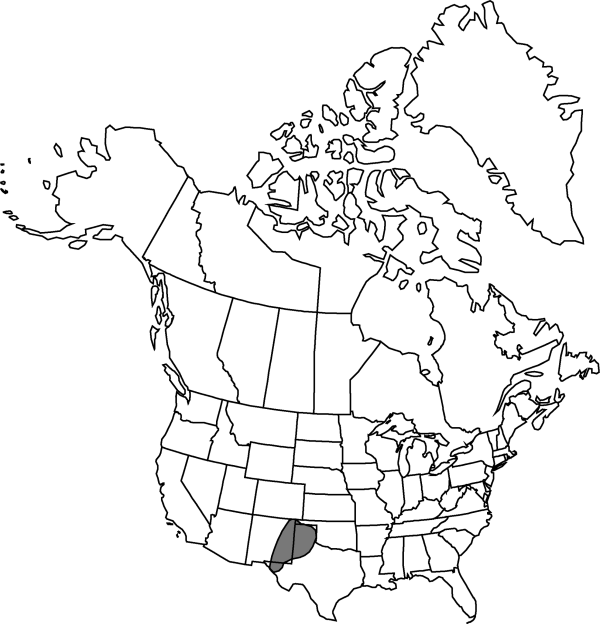Mirabilis linearis var. subhispida
Novon 12: 270. 2002.
Basionym: Mirabilis linearis forma subhispida Heimerl Annuaire Conserv. Jard. Bot. Genève 5: 186. 1901
Synonyms: Allionia gausapoides Standley Mirabilis gausapoides (Standley) Standley
Stems usually erect or ascending, 2.5–12 dm, hirsute, at least basally. Leaf-blades 5–11.5 × 0.1–1 cm, surfaces glabrous or densely hispid. Inflorescences single involucres in axils, or terminal, well branched, with ± well-defined main axis; fruiting involucres 5–10 mm, crosswalls of peduncle hairs usually pale. Perianth pale to deep pink.
Phenology: Flowering late spring–summer.
Habitat: Dry open, sandy, rocky, or calcareous areas, prairies, roadsides, among juniper
Elevation: 1000-1500 m
Distribution
Loading map...

N.Mex., Okla., Tex., Mexico
Discussion
Mirabilis linearis var. subhispida intergrades with Mirabilis rotundifolia and with M. albida through its named phases M. hirsuta, widespread on the Great Plains, and M. eutricha, from the southern plains.
Selected References
None.
Lower Taxa
None.
No values specified."dm" is not declared as a valid unit of measurement for this property.
... more about "Mirabilis linearis var. subhispida"
nipplelike +
acutely tapered;rounded +
glutinous +
petiolate +
symmetric +
green;blue-gray +
glaucous +
lanceolate;linear;linear-lanceolate +
calyxlike +
colored +
persistent +
ovate +
colorful +
not showy +
large +
varying +
absent +
foliaceous +
few +
scanty +
connate +
incomplete +
symmetric +
aerial +
pubescent +
accessory +
1-carpellate +
distributed +
spreading +
crinkled +
cymose +
racemose +
axillary +
forked +
branched +
translucent +
connate +
subtending +
bell--shaped +
accrescent +
herbaceous;papery +
single +
0.1cm;1cm +
opposite +
strongly ascending;spreading +
equal +
5-lobed +
ovate +
well-defined +
basal +
symmetric +
pale;deep pink +
constricted +
abundant +
basal +
Novon +
2002 +
interrupted +
separated +
angular +
paler +
low +
elevated +
tuberculate +
coriaceous +
varying +
0.3-1 times as wide as high smooth or sometimes rugose on sides +
obtuse +
tuberous +
woody +
thick +
membranaceous +
connate +
wrinkled +
Illustrated +
alternate +
exserted +
3;5 +
varying +
bushy +
hirsute +
few +
capitate +
filiform +
high +
low +
inconspicuous +
cross-rugose +
broad +
mucilaginous +
tuberous +
slender +
Mirabilis linearis var. subhispida +
Mirabilis linearis +
variety +
well-defined +
single +
well-defined +
single +
proximal +
1/5 +
gland-tipped +
curved +
narrow +
viscid +
perennial +